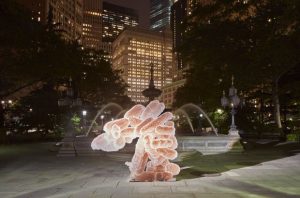John Metcalfe of City Lab writes there is now a giant statue of an E. coli microbe in City Hall Park in Lower Manhattan.
 “Earth Potential: E. coli” is based on a 10,000-times magnified electron-microscope image of the fecal bacterium that causes 265,000 infections in the U.S. yearly, with symptoms including cramps and diarrhea. Made from a digital print on cut-out aluminum, it rests in City Hall Park as part of the larger exhibition, “Earth Potential,” by the Estonian artist Katja Novitskova. The show intends to portray “organisms and bodies” that have “significant research value within the scientific community for their potential to advance our understanding of our species and world,” according to the non-profit Public Art Fund. Aside from E. coli, the other pieces in the show include a huge earthworm, a slippery nematode, and a human embryo magnified to resemble a clump of moldy peaches.
“Earth Potential: E. coli” is based on a 10,000-times magnified electron-microscope image of the fecal bacterium that causes 265,000 infections in the U.S. yearly, with symptoms including cramps and diarrhea. Made from a digital print on cut-out aluminum, it rests in City Hall Park as part of the larger exhibition, “Earth Potential,” by the Estonian artist Katja Novitskova. The show intends to portray “organisms and bodies” that have “significant research value within the scientific community for their potential to advance our understanding of our species and world,” according to the non-profit Public Art Fund. Aside from E. coli, the other pieces in the show include a huge earthworm, a slippery nematode, and a human embryo magnified to resemble a clump of moldy peaches.
Only certain strains of E. coli cause gut-churning maladies; others are beneficial components of the human intestines and boons to science. As the show’s primer explains: “E. coli has been at the center of groundbreaking research: Genetic engineers have used new synthetic biological techniques to recode the bacteria’s genome, potentially changing the organism’s functionality and radically increasing the prospect that humans will have the ability to rewrite the codes for life.”
